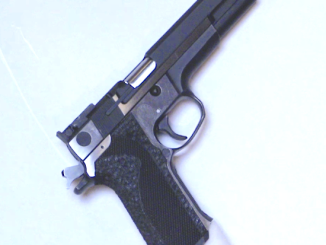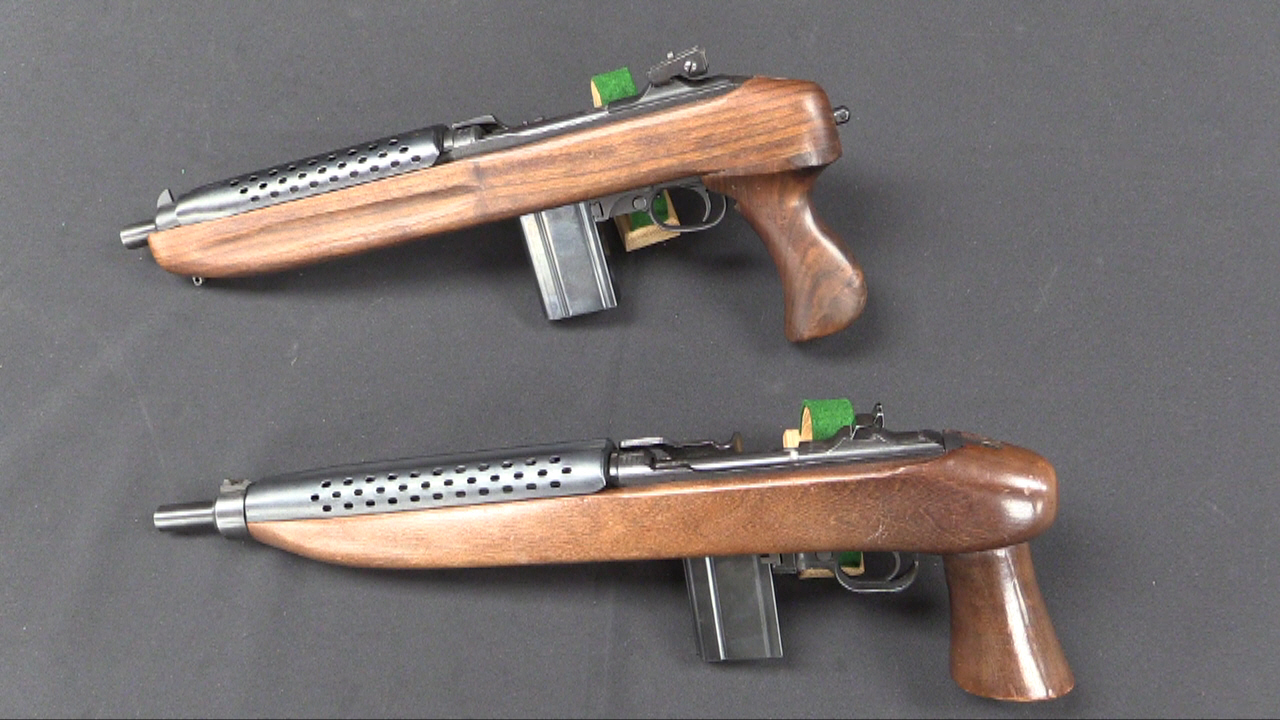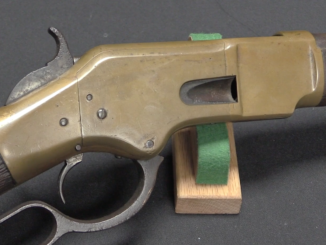This Driggs cannon and its accessories are lot #1117 at Morphy’s April 2019 auction.
Developed between 1883 and 1889 by Lt. William Driggs and Commander (later Admiral) Seaton Schroeder, the Driggs cannon was an improvement on the market-standard Hotchkiss quick-fire cannon of the day. By quick-fire, I am referring to a single-shot cannon that has a recoil mechanism and ejects its empty case automatically, leaving the breech open for rapid reloading and subsequent shot. This was the standard type of naval armament for allowing large vessels to combat small and quick torpedo boats in the late 19th century. The Driggs guns were made in many variations and calibers but limited total quantities until about 1908. This example is a Mk IX type in 37mm, made in 1897.




I have a Driggs Seabury six-pounder shell, unfired with the original casing. I believe they are the equivalent of a 54mm gun.
A six pounder usually is a 57mm gun.
The 79 pounds might be the weight of the barrel only, as was done with muzzle loading cannons. The weight of the muzzle loaders (U.S.) was stamped on the muzzle front. This cannon has got to weigh at least 200 pounds, not including the carriage. Somebody please correct me if I am wrong. I always go see any cannons found in parks, etc. Nice hobby.
You’re not. The weight figure either cast (with bronze or iron muzzle-loaders) or engraved (on later breechloaders like this) on the tube is the mass of the tube itself. It does not include the recoil system (if there is one) or the carriage or mount (whichever the tube is bolted onto).
Knowing the exact mass of the tube was important for lifting and stowage, not to mention calculating the maximum recoiling mass to keep it within the recoil system’s tolerance. This was as true of muzzle-loading guns in casemates or on ships with rope or friction recoil arrestors as it was of the later guns like this with actual recoil absorption systems.
Too much recoil force (mass x velocity) could and in the early days did sometimes result in the tube departing the carriage or mount in the opposite direction of the shot. Which didn’t work too well.
If you think a gun like this might make a mess behind it if that happened, imagine somebody making a mistake causing a similar event with an 11 or 15-inch Dahlgren of Civil War vintage.
Now imagine it happening inside the turret of a monitor.
cheers
eon
The extreme result of an overcharged runaway gun carriage during the age of sail is “man overboard,” generally accompanied by a huge gap in the upper deck railing or a hole in the lower gun deck hull section. As for a turret runaway, “surgeon, get your saw ready.” Of course, this could be wrong.
Sort of. In a monitor turret, which was at best about 1.5x as wide as a Dahlgren was long, an overcharged gun breaking loose usually meant the back side of the turret was thrown half the length of the hull, the gun tube ended up lying half-in and half-out of the turret, the carriage was “busted all to h**l” as one account states, and anyone in the gun’s 4 o’clock to 5 o’clock or 7 o’clock to 8 o’clock arc was pretty much chunky salsa.
The problem with that was there really wasn’t anywhere else to stand in a monitor turret than those two supposedly “safe” wedges of deck space. I think you can see how this could be a serious problem.
Still, it wasn’t quite as bad as an 11-inch or 15-inch fracturing its tube. That tended to just reduce everything solid in the turret to fragments, and reduce the gun crew to smears on the deck and bulkheads.
That’s not even considering an 11-inch or 15-inch shell bore premature. That tended to just remove the turret in pieces and deposit the bits in a different county, or sometimes more than one.
cheers
eon
Facts are fun. So is research.
“(…)during the age of sail(…)”
Well, as armament was becoming heavier, such was it need for propulsive explosives. Naturally having a lot of it aboard means serious consequences if it was ignited in wrong place. Although there was awareness of such possibility and safety precautions were developed, such accidents happen through history:
List of ships sunk due to unintended explosions:
https://en.wikipedia.org/wiki/Category:Ships_sunk_by_non-combat_internal_explosions
Overview of explosions and their causes during Great War:
http://www.gwpda.org/naval/thist24.htm
Similarly to gun powder, certain torpedo types could wreck a havoc inside submarine without detonation of warhead, just due to engine running, as it is producing heat and toxic substances.
HMS Sidon submarine sunk in such circumstances (1955).
K-141 submarine sunk* for some reason (2000).
It is also speculated that this might be reason for loss (1968) of USS Scorpion.
* event described later in more than 1 English-language song, see for example: https://lyrics.fandom.com/wiki/Wolf:K-141_Kursk
is: “(…)some(…)”
should be: “(…)same(…)”
eon- Thank you. I had always wondered why the exact weights. Makes a lots of sense.
Not different today. I’ve seen recoil mechanisms incorrectly adjusted on modern howitzers and that is not something you want to be near.
Do they still mark the weights on modern barrels, like on the M777?
Bet we could make “liqiud” shells.
https://en.m.wikipedia.org/wiki/Liquid_Armor
Bits of Ni-Ti alternating phases, mirco compressed: bang its a solid.
Theres Terminators coming, think.
Shear thickening.
LOL, Antique 37mm with no NFA infringements?? The price just went from “You can’t afford one” to “You can’t even afford to breathe the air in the same room with it” That aside, it is a really nice looking gun and I am sure would be a good time to get to shoot. Ian, are you going to shoot it???
How many collectors are drooling over this cannon?!
The progression went like this 37mm = 1 pdr 47mm = 3 pdr 57mm = 6 pdr, 3 inch/76/2 mm = 12 pdr (note that the weight of shell doubled each step)
4 inch = 25 pdr 4.7 inch = 50 pdr 6 inch = 100 pdr 7.5 inch = 200 pdr 9.2 inch = 400 pdr 12 inch = 800 pdr (pounder values are aprroximate)
The 1 pounder came about due to an international agreement that banned explosive projectiles weighing less than one pound http://www.weaponslaw.org/instruments/1968-saint-petersburg-declaration